What is the 5 out motion offense in basketball
The 5 out motion offense, also known as the open post offense, is a basketball offensive strategy that utilizes the fundamental skill sets of passing, cutting, and screening as well as continuity patterns to create scoring opportunities, typically near the basket or near the perimeter areas of the court.
What are advantages of the 5 out motion offense
Team-oriented offense
One noteworthy advantage of the 5 out motion offense is that it is a team-oriented offense. Essentially, teams that do not have one or two dominant scorers can still obtain success because all players can actively contribute and become viable scoring options when executing the 5 out motion offense.
Fairly easy to teach and it can help players get better
Another strength of the 5 out motion offense is that it is fairly easy to teach for coaches and it can increase the players’ skill sets as well, particularly at the youth basketball level.
In other words, coaches can efficiently teach the basic options of the offense in a relatively short amount and at the same time, the players will be able to get better at the fundamental skill sets of passing, cutting, and screening.
Also, as an added bonus, players, especially at the youth level, will begin to understand the importance of moving the ball (i.e passing the ball to open teammates) and moving without the ball (i.e. cutting to get open).
If these essential principles are able to become reinforced in the minds of the players, then this can help those players further execute the 5 out motion offense with great efficiency as well as any other particular basketball offense in general.
Could be useful for smaller teams
An additional benefit for the 5 out motion offense is that it could be very useful for undersized basketball teams with a limited number of traditional post players and/or teams with multiple guards.
Basically, if an offensive team has a limited number of traditional post players and/or multiple guards, then it could be very difficult to score around the basket with the bigger low post defenders.
The 5 out motion offense seeks to solve this problem by opening up the low post areas and possibly pulling low post defenders away from the basket.
What are disadvantages of the 5 out motion offense
Ineffective against certain types of defensive strategies
One notable disadvantage of the 5 out motion offense is that it may not be as effective if the defensive team implements a strategy such as the pack line defense or a zone defense.
Essentially, in defensive strategies such as the pack line or zone, at least two of the defenders will typically stay near the basket.
When that occurs, it could become more challenging for the offensive team to score around the basket. Furthermore, this problem could be compounded if the offensive team is also not a very good perimeter shooting team as well.
Inadequate when losing a game towards the end
Another weakness of the 5 out motion offense is that it could be inadequate if the offensive team is losing the game by several points, particularly towards the end of the game.
The reason this could be an issue is because the main premise of the offense is to use the continuity patterns and the skills of passing, cutting, and screening to create the best scoring opportunities.
However, doing that will almost certainly take precious seconds from the game clock, which is not helpful in a losing situation.
What is an example of the initial formation for the 5 out motion offense

This is an example of the initial formation for the 5 out motion offense. When executing this type of offensive strategy, each player should fill one of the five primary perimeter areas (or spots) on the court that are the top, the wings, or the corners.
Additionally, each player should be about 12 to 15 feet apart for optimal spacing. Player 1 is at the top, players 2 and 3 are on the wings, and players 4 and 5 are in the corners.
Furthermore, it should be noted that in the 5 out motion offense, the players do not necessarily have to be assigned the traditional basketball positions.
For example, in the traditional basketball sense, player 1 is typically the point guard, player 2 is the shooting guard, player 3 is the small forward, player 4 is the power forward, and player 5 is the center.
However, in the 5 out motion offense, this is generally negligible because all five players play near the perimeter regardless of the fact if that player was to be considered a point guard or a center in the conventional fashion.
In other words, the 5 out motion offense could be thought of as a positionless type of system where the notion of common basketball positions such as guards, forwards, or centers are basically inconsequential.
Furthermore, it should also be noted that although player 1 starts at the top while players 4 and 5 start in the corners, these initial spots are also of little importance because once again, the 5 out motion offense is geared towards positionless basketball to a great degree.
What are the rules for the players within the 5 out motion offense
First, it should be noted that the rules for the players within the 5 out motion offense are dependent on the location of the ball in relation to the top, the wings, or the corners.
Generally speaking, if a player has the ball, then that player should pass to an adjacent teammate and either cut to the basket or screen for another teammate away from the ball.
In addition to that, if a player does not have the ball, then that player should fill an adjacent vacated area on the court whenever it is necessary to do so.
It should also be expressed that these rules are primarily based on two fundamental scoring options within the 5 out motion offense, commonly known as the pass and cut options as well as the pass and screen away options.
The pass and cut rules in addition to the pass and screen away rules are given in more details below.
Pass and Cut Rules
If a player has the ball at the top
If a player has the ball at the top, then that same player should pass the ball to another player on either wing. Following that, the player that passed the ball should cut to the basket and then the player on the wing that is opposite the ball should fill the empty area at the top.
Furthermore, another player in the corner opposite the ball should also fill the vacated adjacent wing area.
Additionally, if the player that cut to the basket does not receive the ball for a potential scoring opportunity, then that same player should fill the vacated corner opposite the ball.
If a player has the ball on the wing and then passes it to the top
If the player with the ball passes it to the top, then that same player should cut to the basket and immediately following that, another player in the adjacent corner should fill the vacated adjacent wing area.
Also, if the player that cut to the basket does not receive the ball for a potential scoring opportunity, then that same player should fill the vacated corner area.
If a player has the ball on the wing and then passes it to the adjacent corner
If the player with the ball passes it to the adjacent corner, then that same player should cut to the basket.
After that, another player at the top should fill the vacated wing area, a player on the wing opposite the ball should fill the top, and a player in the corner opposite the ball should fill the vacated adjacent wing.
Furthermore, if the player that cut to the basket does not receive the ball for a potential scoring opportunity, then that same player should fill the vacated corner opposite the ball.
If a player has the ball in the corner
If a player has the ball in the corner, then that same player should pass the ball to another player at the adjacent wing and cut to the basket.
Next, if that player does not receive the ball at the basket for a potential scoring opportunity, then that same player should fill the vacated spot on the court.
In this case, that would be the exact corner that was just emptied out. This action is also sometimes referred to as a self replace cut.
Pass and Screen Away Rules
If a player has the ball at the top
If a player has the ball at the top, then that same player should pass the ball to another player on either wing. Following that, the player that passed the ball should screen for another player on the wing that is opposite the ball.
Next, the player on the wing opposite the ball that utilizes the screen can execute a curl cut to the basket. Afterwards, the player that set the screen should self replace back to the top while the player in the corner opposite the ball should fill the vacated adjacent wing.
Additionally, if the player that cut to the basket does not receive the ball, then that same player should fill the corner opposite the ball.
If a player has the ball on the wing and then passes it to the top
If the player with the ball passes it to the top, then that same player should screen away for another player in the corner. Following that, the corner player that used the screen can execute a curl cut to the basket.
Next, the player that set the screen should self replace back to the same wing. Furthermore, if the corner player that cut to the basket does not receive the ball, then that same player should also replace themselves at the exact vacated corner.
If a player has the ball on the wing and then passes it to the corner
If the player with the ball passes it to the corner, then that same player should screen away for another player at the top. Following that, the player at the top can execute a curl cut to the basket.
Next, the player that set the screen should self replace at the vacated wing. Also, as that occurs, the player on the wing opposite the ball should fill the top and the player in the corner opposite the ball should fill the vacated adjacent wing.
Furthermore, if the player that cut to the basket does not get the ball for a scoring opportunity, then that same player should fill the corner opposite the ball as well.
If a player has the ball in the corner
If a player has the ball in the corner, then that same player should pass the ball to another player on the adjacent wing. Following that, the player at the top will set a screen for another player on the wing opposite the ball.
From that point, the player on the wing opposite the ball that uses the screen can execute a curl cut to the basket.
What are examples of the basic options for the 5 out motion offense
Pass and Cut – Part 1
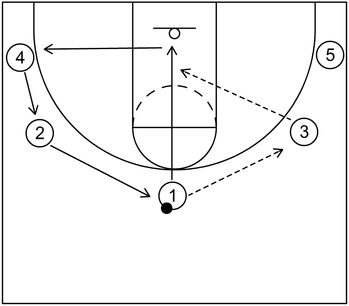
This is an example of the basic scoring options for the 5 out motion offense that consists of players passing the ball to an adjacent teammate and then cutting to the basket.
Additionally, this particular option is potentially the easiest to learn for players of all levels such as youth basketball, high school, college, or the professional ranks.
To begin, 3 receives the ball from 1 and after that, 1 cuts to the basket. As that occurs, 2 fills the top while 4 fills the left side wing area.
Following that, 1 could receive the ball from 3 if that is open. If 1 is not open, then 1 could fill the left side corner.
Pass and Cut – Part 2

Next, 5 receives the ball from 3 and afterwards, 3 cuts to the basket. As that cutting action occurs, 2 fills the right side wing, 4 fills the top, and 1 fills the left side wing.
After that, 3 could receive the ball from 5 and score at the rim. If 3 is not open, then 3 continues the cut towards the left side corner.
Pass and Cut – Part 3
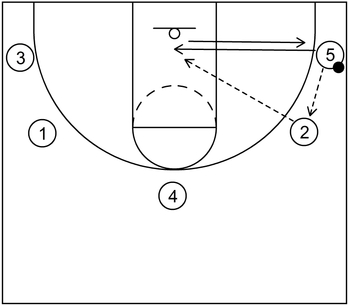
Next, 2 receives the ball from 5 and from there, 5 cuts to the basket. Following that, 5 could receive the ball from 2 and score at the basket if that is open.
Otherwise, 5 should execute a self replace and cut back to the right side corner.
Pass and Cut – Part 4

Next, 4 receives the ball from 2 and immediately after, 2 cuts to the basket. Also, as that happens, 5 fills the right side wing area. Afterwards, 2 could receive the ball from 4 and score at the rim.
If 2 is not open, then 2 could fill the right side corner. From there, the 5 out motion offense could get executed again as a continuity pattern on the left side of the court.
Pass and Screen Away – Part 1

This is an example of the basic scoring options for the 5 out motion offense that consists of the players passing the ball to an adjacent teammate and then screening away for another adjacent teammate.
To start, 3 receives the ball from 1. Afterwards, 2 executes a curl cut to the basket via the screen set by 1.
Also, after the screen away action occurs, 4 fills the left side wing while 1 self replaces at the top. Next, 2 could receive the ball from 3 and score at the basket. If 2 is not open, then 2 fills the left side corner.
Pass and Screen Away – Part 2

Next, 5 receives the ball from 3 and after that, 1 cuts to the basket via the screen set by 3. As that happens, 4 fills the top, 2 fills the left side wing, and 3 self replaces at the right side wing.
From there, 1 could receive the ball from 5 if that is open. Otherwise, 1 continues the cut to the left side corner.
Pass and Screen Away – Part 3

Following that, 3 receives the ball from 5 and then 2 cuts to the basket via the screen set by 4. Also, as that action occurs, 1 fills the left side wing and 4 self replaces at the top.
From that point, 2 could receive the ball from 3 and score at the rim. If 2 does not have the scoring opportunity, then 2 could fill the left side corner.
Pass and Screen Away – Part 4
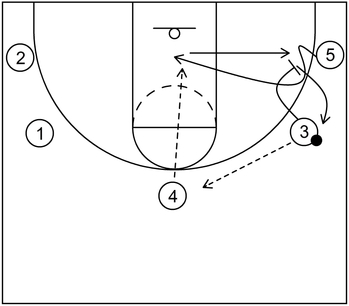
Afterwards, 4 receives the ball from 3 and after that, 5 cuts to the basket via the screen set by 3. Also, as that happens, 3 executes a self replace to the right side wing area.
Next, 5 could receive the ball and score at the basket. If 5 does not receive the ball, then 5 self replaces at the right side corner.
From there, the 5 out motion offense could get executed again as a continuity pattern on the left side of the court.
Affiliate Disclosure: I may earn a commission on qualifying purchases made through the links below.
What are examples of counters for the 5 out motion offense
Backdoor Cut Counter – Example 1

This is an example of a counter for the 5 out motion offense if X3 attempts to deny 3 from receiving the ball near the right side wing.
When that occurs, 3 should execute a backdoor cut to the basket while 5 fills the vacated right side wing area.
Next, 3 could receive the ball from 1 and score at the basket. Otherwise, if 3 does not receive the ball, then 3 could fill the right side corner. Following that, 1 could continue the 5 out motion by passing the ball to either 2 or 5.
Backdoor Cut Counter – Example 2

This is an example of the counter for the 5 out motion offense if X5 tries to stop 5 from receiving the pass from 3. When that happens, 5 executes a backdoor cut to the basket and could receive the ball from 3 for a scoring opportunity near the rim.
If 5 is not open to receive the ball, then 5 could self replace and cut back to the right side corner. From there, 1 could receive the ball from 3 and the 5 out motion could continue as normal.
Backdoor Cut Counter – Example 3

This is an example of a counter for the 5 out motion offense that demonstrates X3 preventing 3 from receiving the ball from 5.
When that occurs, 3 backdoor cuts to the basket and at the same time, 1 fills the right side wing area, 2 fills the top, and 4 fills the left side wing area.
Next, 3 could receive the ball from 5 if that is open and score at the basket. Otherwise, 3 would fill the left side corner.
Backdoor Cut Counter – Example 4

This is an example of a counter for the 5 out motion offense if X1 tries to deny the pass to the top.
When that happens, 1 executes a backdoor cut to the basket and at the same time, 2 fills the top while 4 fills the left side wing area.
Next, 1 could receive the ball from 3 and score near the basket. Otherwise, if 1 is not open, then 1 could fill the left side corner.
Dribble Handoff Counter – Example 1
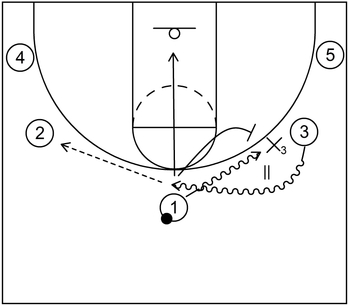
This is an example of a counter for the 5 out motion offense if X3 denies the pass to 3. When that occurs, 1 could execute a dribble handoff with 3 and afterwards, 3 could dribble the ball back to the top.
Following that, 2 could receive the ball from 3 and from there, 3 could cut to the basket or screen away.
Dribble Handoff Counter – Example 2 – Part 1

This is another counter that consists of a dribble weave with drive and kick action for potential scoring opportunities.
To start, X3 denies the wing pass so 1 executes a dribble handoff with 3. Afterwards, 3 executes another dribble handoff with 2. From there, 2 dribbles back to the top.
Dribble Handoff Counter – Example 2 – Part 2

Next, 2 executes another dribble handoff with 1 and then 1 drives toward the basket. Also, as that action occurs, 3 fills the top while 4 fills the left side wing.
From that point, 1 could score near the basket or kick the ball to either 4 or 5. Following that, 1 could fill the left side corner and then the 5 out motion could begin from there.
Screen Rejection Counter – Part 1

This is an example of a counter derived from Harry Perretta’s 5-Out Motion Offense, Volume 2 that demonstrates a player rejecting a screen instead of receiving it.
This particular counter could be useful if the defender that is being screened attempts to jump over the top of the screen to avoid it.
To start, 3 receives the ball from 1. Next, 2 cuts toward the screen set by 1 as if to receive it but then rejects that screen with a backdoor basket cut.
As that happens, 4 fills the left side wing while 1 replaces at the top. Afterwards, 2 could receive the ball from 3 and score at the rim. If 2 does not receive the ball, then 2 could fill the left side corner.
Screen Rejection Counter – Part 2
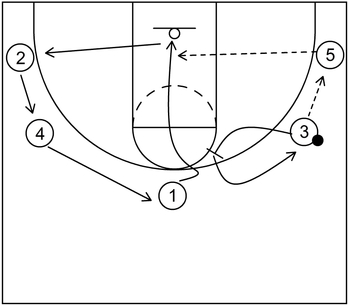
Next, 5 receives the ball from 3. Following that, 1 rejects the screen set by 3 and cuts to the basket. At the same time, 4 fills the top, 2 fills the left side wing area, and 3 self replaces at the right side wing.
From that point, 1 could receive the ball from 5 and score at the rim. If that is not available, then 1 could cut to the left side corner.
Screen Rejection Counter – Part 3

After that, 3 receives the ball from 5. After that, 2 rejects the screen set by 4 and cuts to the basket. While that occurs, 1 fills the left side wing and 4 replaces at the top.
Following that, 2 could receive the ball from 3 for a scoring opportunity. If it is not open, then 2 fills the left side corner.
Screen Rejection Counter – Part 4
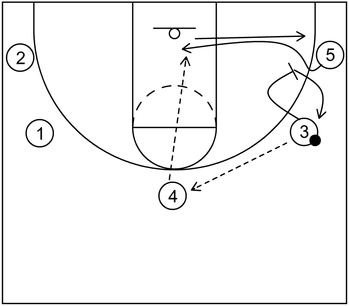
Next, 4 receives the ball from 3. From there, 5 rejects a screen set by 3 and cuts to the basket. While that happens, 3 self replaces at the right side wing.
Next, 5 could receive the ball from 3 and score near the rim. However, if 5 is not open, then 5 could self replace at the right side corner.
Slip Screen Counter – Part 1

This is an example of a counter for the 5 out motion offense that occurs when a player slips the screen to the basket.
This particular counter could be helpful if the screener’s defender attempts to switch to the offensive player that would be receiving the screen.
It should also be noted that prior to the slip screen action happening, the slipping player should initially wait until the screen user is parallel to or slightly behind the potential screener’s body before slipping to the basket.
To start, 3 receives the ball from 1. Following that, 2 cuts to the top via the screen set by 1 while 4 fills the left side wing and then 1 slips to the basket.
Next, 1 could receive the ball from 3 if that is open. Otherwise, 1 should fill the left side corner.
Slip Screen Counter – Part 2

After that, 5 receives the ball from 3. Next, 2 cuts to the right side wing via the screen set by 1 while 4 fills the top and 1 fills the left side wing area.
Additionally, 3 should slip to the basket and potentially receive the ball from 5. If that is not feasible, then 3 should fill the left side corner.
Slip Screen Counter – Part 3

Next, 2 receives the ball from 5. Afterwards, 1 cuts to the top via a screen set by 4 while 3 fills the left side wing area. Also, 4 slips to the basket and could receive the ball from 5.
If 4 does not receive the ball for a scoring opportunity near the rim, then 4 cuts to the vacated left side corner.
Slip Screen Counter – Part 4

For this part, 1 receives the ball from 2. Following that, 5 cuts to the right side wing area via a screen set by 2. After that, 2 immediately slips to the basket and could receive the ball from 1.
If 2 is not open, then 2 should self replace at the right side corner.
What is an example of pick and roll options for the 5 out motion offense
Pick and Roll – Part 1

This is an example of a pick and roll options for the 5 out motion offense.
For this sequence, a player in possession of the ball passes it to another teammate and then follows that pass with an on-ball screen. Afterwards, that same player will roll to the basket for a possible scoring opportunity.
To begin, 3 receives the ball from 1 and then 3 dribbles to the high post area via the on-ball screen set by 1. Also, as that occurs, 1 rolls to the basket and 5 fills the vacated right side wing area.
From there, 1 could receive the ball and score near the basket. Additionally, 2 or 4 could receive the ball and if that happens, then 1 fills the right side corner while 3 fills the top.
Pick and Roll – Part 2

For this part of the example, 2 received the ball from 3. Next, 4 receives the ball from 2 and after that, 4 dribbles towards the mid-post area via the corner ball screen set by 2.
At the same time, 2 rolls to the basket while 3 fills the left side wing area, 5 fills the top, and 1 fills the right side wing area.
From that point, 2 could receive the ball and score near the basket. Also, 3 or 5 could receive the ball as well and if that transpires, then 4 could fill the left side corner while 2 fills the right side corner.
Pick and Roll – Part 3

For this part, 3 received the ball from 4. After that, 5 receives the ball at the top and then 5 dribbles toward the basket via the on-ball screen set by 3.
Also, as that happens, 3 rolls to the basket while 1 fills the top and 2 fills the right side wing area.
After that, 3 could receive the ball and score at the rim. Additionally, 4 could receive the ball and if that takes place, then 5 could fill the left side wing area while 3 fills the right side corner.
Pick and Roll – Part 4

Next, 4 received the ball from 5 but the jump shot is not available. So, 5 receives the ball again from 4 and then dribbles toward the baseline via a step-up screen set by 4.
Furthermore, as that happens, 4 rolls to the basket, 1 fills the left side wing area, 2 fills the top, and 3 fills the right side wing area.
Following that, 4 could receive the ball from 5 and score near the basket. Also, 1 could receive the ball and if that happens, 5 fills the left side corner while 4 fills the right side corner.
At this point, the pick and roll action could get initiated again as a continuity pattern if necessary.
What is an example of a quick hitter for the 5 out motion offense
Quick Hitter – Part 1

This is an example of a quick hitter for the 5 out motion offense derived from Jerry Petitgoue’s Open Post Motion Offense and it features a stagger screen and a continuity pattern to create scoring opportunities near the basket or from the perimeter.
To start, 4 and 5 cut to the wings via the pin down screens set by 2 and 3. Afterwards, 4 or 5 could receive the ball from 1. For this example, 4 receives the ball from 1.
Quick Hitter – Part 2
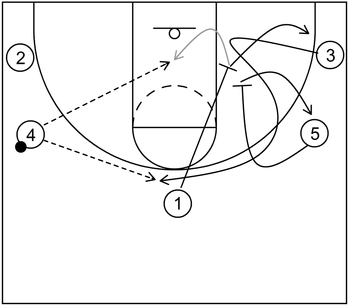
Next, 3 begins to set up the defender by slowly cutting towards the basket. As that occurs, 1 and 5 cut towards the mid-post and low post areas.
Afterwards, 3 cuts to the top via the stagger screen set by 1 and 5. Following that, 3 receives the ball from 4 and could take the jump shot if open.
Also, as a secondary option, 1 could slip into the lane after setting the screen, receive the ball from 4, and score near the rim.
Additionally, if 3 receives the ball at the top but does not take the jump shot, then 5 can self replace at the right side wing while 1 cuts to the right side corner.
Quick Hitter – Part 3
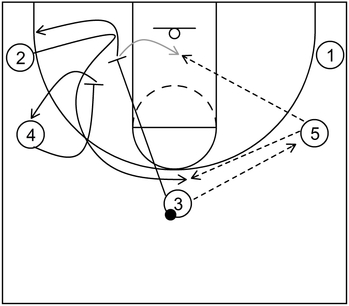
At this point, it is possible to execute the quick hitter as a continuity pattern. Therefore, 5 receives the ball from 3. Following that, 2 begins to set up the defender by slowly cutting towards the basket.
As that happens, 3 and 4 cut towards the mid-post and low post areas. Next, 2 cuts to the top by way of the stagger screen set by 3 and 4. From there, 2 receives the ball from 5 and could take the jump shot if open.
Also, as an alternative option, 3 could slip into the lane after setting the screen, receive the ball from 5, and score near the basket.
Furthermore, if 2 receives the ball at the top but the jump shot is not available, then 4 can self replace at the left side wing area while 3 fills the left side corner.
What are examples of entries for the 5 out motion offense
Box

This is an example of an entry set play that begins as a box formation but switches into the 5 out motion offense. To start, 2 and 3 cut to the wings via the down screens set by 4 and 5.
Additionally, after setting the screens, 4 and 5 pop out to the left and right side corners. Next, 2 or 3 could receive the ball from 1 and then the entry can transition into 5 out motion.
Horns A

This is an example of an entry set that begins in the Horns set but also has the possibility of transitioning into the 5 out motion offense.
To start, 3 cuts to the right side wing via a wide pin down screen set by 5. After that, 3 receives the ball from 1. Immediately after, 1 cuts across to the left side wing via the flare screen set by 4.
Next, 1 could receive the cross court skip pass from 3 and take the jump shot if open.
Additionally, if 3 does not take the shot or 3 does not receive the ball in the first place, then 4 could fill the top while 5 fills the right side corner. From that point, the offense could change into 5 out motion.
Horns B – Part 1

This is another example of an entry that starts in the Horns formation with the possibility of switching into the 5 out motion offense. To begin, 5 receives the ball from 1 and then 1 cuts to the basket.
If open, 1 could receive the ball from 5. If that is not open, then 3 cuts to the right side wing area to receive the ball from 5 while 1 fills the right side corner.
Additionally, 2 cuts to the left side wing via a wide pin down screen set by 4 and from there, 4 fills the left side corner. It should also be noted that the weak side action occurs simply to occupy the defense.
Horns B – Part 2

Next, 3 dribbles to the top via an on-ball screen set by 5. Also, 5 rolls to the basket after setting the screen and 1 fills the right side wing area. After that action happens, 5 could receive the ball from 3 and score near the rim.
If 5 does not receive the ball, then 5 can fill the right side corner. Additionally, 2 could receive the ball from 3 and then the offense can convert into 5 out motion.
Flex

This is an example of an entry derived from the flex offense that could potentially change into the 5 out motion offense. To begin, 4 receives the ball from 1 and then 2 receives the ball from 4.
Next, 3 cuts to the basket via the flex screen set by 5 and could receive the ball from 2 for a potential scoring opportunity near the rim.
If 3 does not receive the ball from 2, then 3 could cut towards the left side corner. Also, 1 could cut to the right side wing, 4 could fill the top, and 5 could pop to the right side corner after setting the screen.
At that point, it would also be possible to execute 5 out motion.
Princeton Chin – Part 1

This is an example of the Chin series from the Princeton offense that could possibly transition into the 5 out motion offense.
It is derived from Winning With the Princeton Offense by Lee DeForest.
To begin, 4 receives the ball from 1 and then 2 receives the ball from 4. Afterwards, 1 cuts to the basket via the back screen set by 5.
From there, 1 could receive the ball near the rim if that is open. Otherwise, 1 cuts through to the left side corner.
Princeton Chin – Part 2

Next, 4 cuts to the basket via the screen set by 5 at the top. From there, 4 could receive the ball from 2 and score near the rim. If 4 does not receive the ball, then 4 could cut to the right side corner.
At this point, all five players are in the proper spots so it is possible to execute the 5 out motion.
What are examples of breakdown drills for the 5 out motion offense
Drill 1
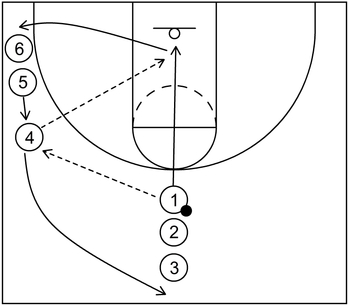
This is an example of a breakdown drill for the 5 out motion offense. The objective of this drill is to help the players practice passing to a teammate and cutting to the basket.
There are two lines; the first line at the top and the second line near the left side wing. It is also possible to move the wing line to the right side as well or set up another line on the right side as well.
For the drill, 4 receives the ball from 1 and then 1 cuts to the basket. Afterwards, 1 receives the ball from 4 and then scores at the rim.
1 gets the ball out of the next and passes the ball to the next player at the top, which would be 2 in this case. From there, 1 moves to the back of the line on the wing (behind 6) while 3 moves to the back of the line at the top (behind 3).
After that, the drill continues until all players have participated in both lines.
Drill 2

This is an example of a breakdown drill for the 5 out motion offense. The purpose of this drill is to help the players practice passing the ball to a teammate and screening away for another teammate.
There are three lines; the first line is at the top, the second line is on the left side wing and the third line is on the right side wing.
To begin the drill, 4 receives the ball from 1 and then 7 receives the screen set by 1 and executes a curl cut to the basket. After that, 7 receives the ball from 4 and scores at the rim.
From that point, 7 gets the ball out of the net and passes it to the next player in the first line, which would be 2 in this situation.
Next, 4 cuts to the back of the first line, 7 cuts to the back of the second line, and 1 cuts to the back of the third line.
What are offensive strategies that are comparable to the 5 out motion offense
Each of the basketball offenses below could be utilized by undersized teams, guard-oriented teams, or teams that do not have one or two dominant scorers.
The 1-4 high offense is a basketball offensive strategy that features one player at the top and four players across the wings and high posts. This offense is useful for guard-oriented teams because it is possible to utilize a variety of on-ball and off-ball screens to create scoring opportunities.
The 4 out 1 in motion offense is a basketball offensive strategy that features four players near the perimeter and typically one post player. This offense could be very useful for teams with multiple guards or teams with a post player that can set on-ball screens, or teams with an undersized post player that can play near the high post area.
The Circle offense is a variation of the 5 out motion and it uses a series of cuts and continuity patterns to create scoring opportunities near the basket. This type of offense could be very advantageous for undersized and/or guard-oriented teams.
The Horns offense consists of a ball handler at the top, two high post players, and two players in the corners. This offense could be useful because it is possible to play through the high posts or initiate various off-ball and on-ball screens to create scoring opportunities for teams with multiple guards or undersized post players.
The Princeton offense could be used to create scoring options for multiple players, primarily via backdoor cuts and various off-ball screens.